21.12.2014 - 3.1.2015
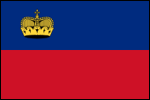 Admittedly, I like not particularly all the hype about Christmas and Yule.
And I'm not an avid New Year's Eve partygoers.
Therefore, I "buzzed off" for the holidays at the end of the year and the time between Christmas and New Year in an area, where you can sometimes be alone and undisturbed move/stop without being equal too far away from civilization: in the mountains of the Principality of Liechtenstein.
Admittedly, I like not particularly all the hype about Christmas and Yule.
And I'm not an avid New Year's Eve partygoers.
Therefore, I "buzzed off" for the holidays at the end of the year and the time between Christmas and New Year in an area, where you can sometimes be alone and undisturbed move/stop without being equal too far away from civilization: in the mountains of the Principality of Liechtenstein.
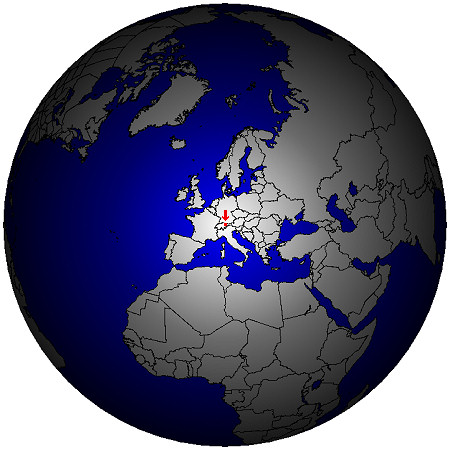 As a base camp and location for the radio station I used again the Mountain Inn Sücka (in German: Berggasthaus Sücka, www.suecka.li).
It belongs to the municipality of Triesenberg and is located at 1402 m and above the urban district Steg near the ski resort of Malbun.
The exact position (47°6′58,6″N, 9°33′54″O, Locator JN47SC) you'll find, among other things here.
As a base camp and location for the radio station I used again the Mountain Inn Sücka (in German: Berggasthaus Sücka, www.suecka.li).
It belongs to the municipality of Triesenberg and is located at 1402 m and above the urban district Steg near the ski resort of Malbun.
The exact position (47°6′58,6″N, 9°33′54″O, Locator JN47SC) you'll find, among other things here.
How to easily get into the Principality of Liechtenstein and what you can experience far from the radio station also in the winter there, I already told in the reports on my 2. and 3. trip there.
This time, the report contains more over the radio activity itself.
Go to "chill out" and relaxing for me goes besides plenty of rest and good food and the homebrew and last but not least to transmit via radio.
And the latter, I indulged once again extensively, although walking also not neglected.
Assembly and disassembly of the antenna ![]()
 First I went to the construction the antenna.
Since I knew the vicinity of the Mountain Inn already from previous years there, I intended this time to build a larger antenna.
Previously I had used for bracing the antenna always points relatively close to the house.
This time 2 large trees were my goals, which are 100 m and 65 m away.
These distances I already determined in the outset on www.findlotsize.com.
Since the distances are large, I had as a precaution 2 rolls with 100 m and 2 mm thick, braided lines (polypropylene), 50 m mason's lacing cord (1 mm thick) and a golf ball with hole as a fling-weight in the luggage.
First I went to the construction the antenna.
Since I knew the vicinity of the Mountain Inn already from previous years there, I intended this time to build a larger antenna.
Previously I had used for bracing the antenna always points relatively close to the house.
This time 2 large trees were my goals, which are 100 m and 65 m away.
These distances I already determined in the outset on www.findlotsize.com.
Since the distances are large, I had as a precaution 2 rolls with 100 m and 2 mm thick, braided lines (polypropylene), 50 m mason's lacing cord (1 mm thick) and a golf ball with hole as a fling-weight in the luggage.
After a few tries I was able to throw the mason's lacing cord with the attached golf ball through the top of the tree and over a branch, that was about 25 m above the ground.
Then I knotted the mason's lacing cord with the thicker string, pulled the first arm of the prepared wire antenna slightly up and undid the mason's lacing cord again, when I held the thick cord in my hands.
The remaining thick string I wrapped first temporarily down around the tree.
At the 2. tree I repeated this procedure and finally pulled both antenna arms punitive upwards.
The construction took about one hour, because I had to deal with the hand rather steep (about 30°) between the 2 trees several times.
Fortunately at this time was only relatively little snow, about 10 cm.
In the end the antenna, made from twice 20 m wire and 8 m lead, was in a height of about 10 to 12 m tilted on the slope.
The design I would describe as an angled Dipole or bent Doublet.
The feed line I moved horizontally towards the window and clamped it there in the window frame and led it into the room.
The station stood on a small table by the window.
Although the two-wire line well wedged in the window frame, I combined them with a short line at the window hinge.
Otherwise, it could happen that the wire slips out, if opening the window careless.
That could eventually pulls the whole station off the table.
Perhaps a few tips for those, who want also to build up their antenna between the trees too.
The thin mason's lacing cord slipped significantly better over the branches, and then with the golf ball complains down, as it would have enabled the thicker cord.
For fixing the antenna, the mason's lacing cord would have been sufficient, but there were no rolls of 100 m to buy.
But it was more than the length of the available rolls with 50 m required (25 m upwards over the branche, 25 m to the ground floor plus some reserve, since one can not stand directly under the tree).
However, an interfering knot to join 2 strongs of each 25 m I wanted to avoid, because the knot perhaps even dissolves.
Already in the summer I had experimented at home with 0.5 mm thick fishing line (monofil) to pull the thicker holding strings on the branches.
This line is thin, available in lengths of 100 m and should actually good slip over the branches.
The surface of the line is rough fairly quickly, especially when the bark of the branches is rough.
Ater a few uses they no longer slide right over the branches.
How I do unfortunately had to find out, that the golf ball with a weight of 43 g was relatively light.
As a result, the with it weighted line slipped sometimes only then after a short tug on the line through the branches.
Next time I will therefore use a heavy duty, large nut, which should be even good to throw anyway.
However the antenna disassembly in the morning of the departure day, turned out to be much easier.
I just had to loose the lines on the bottom of the trees and could then pull the bracing from the trees.
The antenna was then rolled up neatly together bracing for the next use.
Luckily I had at hand the snowshoes, because without them it would otherwise be difficult to come on the slope to the trees by the end of the holiday, because snow lying 75 cm high to the ground.
Radio station ![]()
After the construction of the antenna, the structure of the radio station followed.
That went pretty quickly, since it was only necessary to interconnect transceiver, power supply and antenna.
As transceiver I used again an Elecraft K1 for 40, 30, 20 and 17 m with 5 W output power.
As an external power supply a LiFePo4 battery served with a capacity of 4.5 Ah, which I recharged via an AC adapter during breaks in operation.
The match to the feed line took over the internal antenna tuner of the K1.
And at this point, the construction stopped because I had not taken the right adapter (BNC-to-dual-post adapter).
What should I do?
The symmetrical ribbon cable could not be safely connected to the BNC connector on the transceiver.
Luckily I had, for whatever reason, still took a short coaxial cable with BNC connectors on both sides.
This was quickly divided in the middle and exposed shield and center conductor.
Also the prepared two-wire line was slightly shortened and the 2 thereto attached banana plugs were cut off.
What then emerged although did not look particularly stylish, but worked for the duration of my holiday without problems.
I twisted the inner wire with one wire of the two-wire line and isolated the joint.
Then, in the same way followed by the connection of the other wire to the shield.
Finish - plug in - does not work!
What was going on again?
The BNC plug got stuck and not wobbled on the jack.
Even the twisted wires were fine.
Since I discovered that I had indeed hit a little too much on the inner conductor and the dielectric, when stripping the inner conductor of the 5 cm long coaxial cable 5 cm.
As a result, the already soldered inner conductor of the plug sticking out not far enough into the plug, so there was no contact with the socket.
After pushing back the inner conductor everything worked as it should.
The tuner was able to adjust the antenna on all 4 bands.
The effect of the joint at the junction of 50 Ω (coaxial/transceiver) to 240 Ω (ribbon cable) the tuner resembled alike with.
Radio operation ![]()
 The propagation conditions predicted on the radio operation was nothing good in view.
For the start of the holiday www.hamqsl.com was preceded conditions both for the day and for the night on the lower bands poor (poor) and on the middle bands also not particularly better (fair).
But notice!
You should not deterred by such predictions to transmit via radio, because there are only (as the name suggests) predictions of the possible conditions.
It does not represent measurements of the real conditions.
In order to assess the propagation conditions, you should go to the bands, watch beacons and last but not least call CQ.
The propagation conditions predicted on the radio operation was nothing good in view.
For the start of the holiday www.hamqsl.com was preceded conditions both for the day and for the night on the lower bands poor (poor) and on the middle bands also not particularly better (fair).
But notice!
You should not deterred by such predictions to transmit via radio, because there are only (as the name suggests) predictions of the possible conditions.
It does not represent measurements of the real conditions.
In order to assess the propagation conditions, you should go to the bands, watch beacons and last but not least call CQ.
Regardless of the predictions I sat thus on some days in the morning to the station, at others days it was the late afternoon hours.
The times were determined only by the other holiday activities.
Radio operating like a well organized DXpedition I did not want to make.
Even knowing at which times which band is theoretically usuable at all remained unconsidered.
I've tried it always first on the highest available band (in this case 17 m) and then moved to a lower frequency or the next lower band, if nobody answered within 10 minutes on my CQ.
Although I called CQ as QRPer always near the QRP frequencies, but I did not hesitate to put the station on a clear frequency between powerful stations.
Thus, it was inevitable that one or another station moved and get on my back because they simply did not hear me.
However, then the number of QSO's rose on always.
The CQ calls I sent at a rate of about 60 bpm (12 wpm) to facilitate slower QSO partners recording.
Some of the faster radio operators sometimes cut back noticeably their speed after sending their callsign, others do not.
I could absorb them anyway.
Only I would not send as fast like this guys.
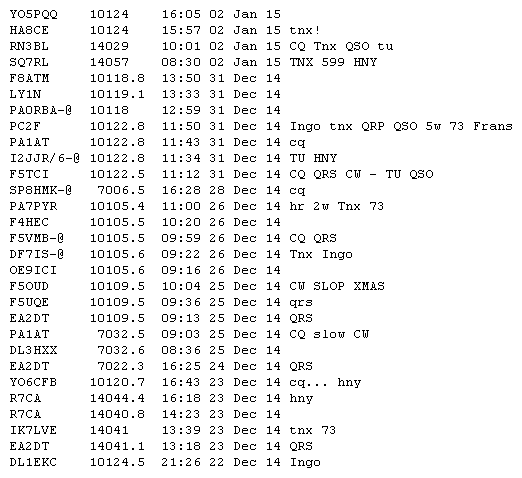 After my return to Germany I saw after all, what could be found to HB0/DK3RED/P at the DX Cluster.
Some messages I could assign a larger crowd at the frequency used by me.
Other messages seemed again to have had no effect.
After my return to Germany I saw after all, what could be found to HB0/DK3RED/P at the DX Cluster.
Some messages I could assign a larger crowd at the frequency used by me.
Other messages seemed again to have had no effect.
A pile-up as cause really rare stations do't occurred at any time.
That was good, because I wanted to enjoy to transmit via radio and do not have to put up with troublemakers or self-appointed band-policeman.
Only a few times I had to deflate some stations that, even though I was send the beginning of the recorded call sign or the entire recorded call sign and it was not her, again responded to call.
Yes, also such stations get a QSO, but only after the end of the currently running QSO's.
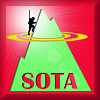 Inquiries as my activity counts for the SOTA program or if I have a corresponding reference, I had to deny.
Especially when there is snow, those activities in the high mountains (the lowest, utilizable peak is 2000 m high) are only for experienced mountaineers and nothing for normal hikers like me.
Maybe I'll climb on a future stay in Liechtenstein on one or the other evaluable for SOTA summit and take my radio station.
But this time, the station remained in the Mountain Inn.
Inquiries as my activity counts for the SOTA program or if I have a corresponding reference, I had to deny.
Especially when there is snow, those activities in the high mountains (the lowest, utilizable peak is 2000 m high) are only for experienced mountaineers and nothing for normal hikers like me.
Maybe I'll climb on a future stay in Liechtenstein on one or the other evaluable for SOTA summit and take my radio station.
But this time, the station remained in the Mountain Inn.
Statistics ![]()
In the end I was able to reach 359 QSO's in just over 30 hours in 11 days on the 4 available bands: 37 QSO's (10 %) at 40 m, 219 QSO's (61 %) at 30 m, 85 QSO's (24 %) at 20 m, 18 QSO's (5 %) at 17 m.
The QSO partner were in 36 DXCC entities (9A, DL, EA, ES, EU, F, G, GM, GU, GW, HA, HB9, I, IS0, JA, LA, LY, LZ, OE, OH, OK, OM, ON, OZ, PA, RA2, RAas, RAeu, S5, SM, SP, UR, YL, YO, YU, Z3), in 7 CQ-zones (14, 15, 16, 17, 19, 20, 25) and on 3 continents (AS, EU, NA).
As expected, most stations had their position in Europe.
But 4 DX-stations in the Asian part of Russia and a station in Japan reached me also.
The shortest distance was 16 km, the longest 9783 km.
The 30m band was particularly useful because it was open to the times when I was sitting at the station.
On the other hand, there may be no contests, which made a positive impact especially on the weekends.
If you would like to know if you already had a QSO with me, so please look in the HB0-logbook.
I was able to update the logbook until after my return to Germany.
Maybe that's the reason why some radio amateurs even called me several times per band and each time got her QSO.
In a very "persistent" radio amateur I noticed that even without the supervision of a computer already in Liechtenstein, so I could call him at the third call with his name.
He himself thought it was not from his 4. call - again on the same band.
Speaking of computers: The logbook I wrote in Liechtenstein was old-fashioned with paper and a pencil.
This is very handy, although you will notice only very few double QSO's.
For the first hand no separate power supply for the computer is required, for the second hand the paper logbook can not be disturbed by stray RF like the computer along with the required peripherals.
You can write in this way also broken QSO's or heckles that can not be entered in the electronic logbook.
Back at home I typed the logbook entries into the computer.
If you do not have thousands QSO's, that's done fairly quickly.
QSL cards ![]()
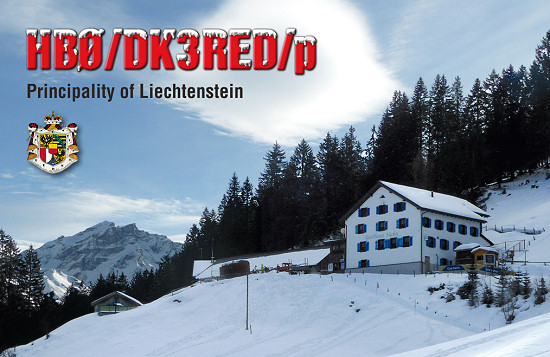 Shortly after my return already the first QSL cards arrived a direct way.
A SWL card was among them. In the meantime (at 15.2.2015) were already almost all QSL cards send via bureau without waiting for incoming QSL cards.
Only a few cards I have not been sent yet.
These are the cards to the receiver, which I already know from unreturned QSL cards for other QSO's that they are not members of a club.
Even QSO partners who had indicated on QRZ.com as QSL information "only eQSL", "only LOTW" or "only direct" were not considered yet.
If this QSO partner want to have a QSL card, they must first send a paper QSL card to myself, because I am a notorious card collectors.
Shortly after my return already the first QSL cards arrived a direct way.
A SWL card was among them. In the meantime (at 15.2.2015) were already almost all QSL cards send via bureau without waiting for incoming QSL cards.
Only a few cards I have not been sent yet.
These are the cards to the receiver, which I already know from unreturned QSL cards for other QSO's that they are not members of a club.
Even QSO partners who had indicated on QRZ.com as QSL information "only eQSL", "only LOTW" or "only direct" were not considered yet.
If this QSO partner want to have a QSL card, they must first send a paper QSL card to myself, because I am a notorious card collectors.
The QSL cards was printed in high quality at the QSL-Shop.
Thankyou ![]()
A big thank you I want to resend in this way to the operator of the Mountain Inn Sücka (www.suecka.li), the family Schädler.
To be able to be active with a radio station is at the present time not everywhere like this.
I also want to thank all of you who were able to resume my weak signals and answered my CQ calls.
It has given me again a lot of fun, especially since I've met again some already known hams from previous radio amateurs "on air".
I hope to have helped one or the other to reach a new DXCC entity, for another point on one or other award list, or at least a nice QSO.
Liechtenstein although is not listed in any "most-wanted" list, but the demand for this DXCC entity is relatively high.
Since Liechtenstein has signed the CEPT agreement, all other necessary formalities with the license application is unnecessary.
You must only get back on your feet and take your little radio station with you.
Then you can reach a few hundred connections in a short time even on holiday style.
73/72 de Ingo, DK3RED - Don't forget: the fun is the power!